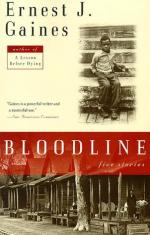|
This section contains 12,957 words (approx. 44 pages at 300 words per page) |

|
SOURCE: Callahan, John F. “Hearing is Believing: The Landscape of Voice in Ernest Gaines's Bloodline.” Callaloo 7, no. 1 (winter 1984): 86-112.
In the following essay, Callahan contends that in Bloodline “voice becomes a transforming agent” that allows the characters to realize their identities and pursue changes that will result in greater freedom than they had previously experienced.
The way home we seek is that condition of being at home in the world which is called love and which we term democracy.
—Ralph Ellison
I
“Usually,” Ernest Gaines has said, “once I develop a character and hear his voice, I can let him tell the story. My writing is strongest when I do that. …”1 Gaines's voice invites belief, and, as Michael Harper wrote in his poem for Gaines, because “one gets the flow/ …, we must believe the writer,/so I believe.”2 Authenticity is the starting point, and Gaines is as scrupulous...
|
This section contains 12,957 words (approx. 44 pages at 300 words per page) |

|


